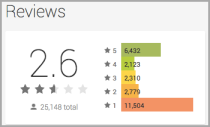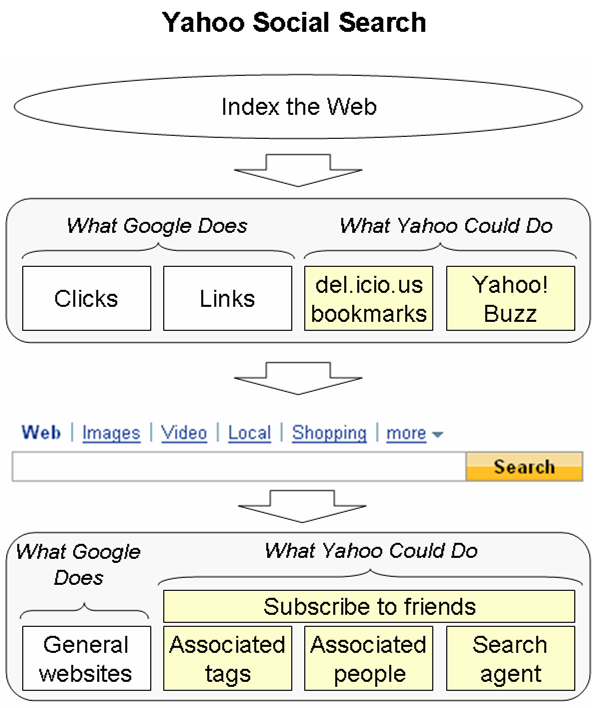10 examples of fabulously flawed product-first thinking
November 5, 2013 9 Comments
In talking about jobs-to-be-done here, I sometimes think that all I’m doing is stating the obvious. I mean, isn’t it obvious that you’d create something that helped fulfill a need or desire? What else would you do?
But I’ve seen in my own work experience, and across a multitude of initiatives in other industries, cases where that’s not necessarily the case. Invention was the thing. I mean that in this sense:
Invention creates. Innovation changes.
Exercising creative chops was the focus, with a thought that customers would have to take up this amazing thing invented. But unfortunately, that’s not generally the case. The invention is not adopted, and thus nothing changes for the target market. Innovation does not occur. The invention either does not address a job-to-be-done or the proposed solution was nowhere near satisfying the specific outcomes of an applicable job-to-be-done.
To illuminate how this “product-first” dynamic is a pervasive dynamic, I’ve collected ten examples of it. While the plural of anecdote is not data, see if you recognize similar examples in your own experience.
1. Because Apple, Microsoft, Google did it!
 Context
Context
Kareem Mayan wrote a great post Why only fools write code first. In it, he stated, “I have a confession to make: I’m 35, and until last year, I started building companies by creating a product.” The post describes on his evolution in thinking, focusing first on customer needs before building anything.
Product-first thinking
In the comments, someone wrote:
“Almost all of the successful startups I know of built a product first, simply because the founder wanted. Apple, Microsoft, Google, Dropbox — some of these are famous even today for never doing user surveys.”
This argument expressed skepticism about Kareem’s point.
Analysis
A good example of the ongoing pervasiveness of product-first thinking. It really is everywhere. Here, the commenter displays a classic example of the survivor bias. A focus on only those companies that made it, and what they do. Ignoring that perhaps dozens of competitors also charged ahead with their own product-first approaches. And were nowhere near as successful.
It’s like looking at the ways lottery winners live, and saying that’s the way you should live too. They’re not connected.
Of course, it’s also possible the commenter actually has no idea what those companies do in terms of understanding customer needs…
2. The “what you can do for us” attitude

Yahoo home page 2002, via All Things D
Context
Way before Marissa Mayer joined Yahoo, the company was a case study in mediocrity. From its glory days in the 90s, it had managed to become a bloated collection of media properties, without a coherent strategy due to a succession of changing executives and business models.
Product-first thinking
As reported by Kara Swisher on All Things D, Yahoo’s home page became increasingly overrun with links. To cram more stuff above-the-fold, font sizes shrunk. It became a nasty hodge podge of links that no longer related to what users wanted.
As Yahoo’s Tapan Bhat, SVP of Integrated Consumer Experiences noted, “It had nothing to do with the user, but what Yahoo wanted the user to do.”
Analysis
What Yahoo wanted the user to. What a wonderful expression of the approach. It’s such a pernicious mode, where the needs of the company eclipse those of the customers. Call it inside-out thinking. When the company’s, not the customers’, needs drive product and service decisions, it’s a good bet customers will turn elsewhere. It’s a great opportunity for competitors.
3. Dazzled by the invention

Source: NBC Bay Area
Context
Anyone remember the hype over Dean Kamen’s project code named Ginger back in 2001? Turned out to be the Segway, that amazing triumph of technology that allowed people to travel on a motorized two-wheel scooter. It really is amazing, with its self-balancing mechanism, easy navigation and smooth ride.
Product-first thinking
It was hailed as the next coming of great technology. No really, it was. Here are quotes by both Steve Jobs and Jeff Bezos prior to its launch:
Jobs: “If enough people see this machine, you won’t have to convince them to architect cities around it; it’ll just happen.” (#)
Bezos: “You have a product so revolutionary, you’ll have no problem selling it.” (#)
Wow! So what happened? Well, have you taken your Segway out for a spin today? It missed the mark in terms of how frequent the job-to-be-done was. For me, Segways are what tourists rent to travel around Golden Gate Park in San Francisco.
Analysis
My own perspective is that Segway is an optimum mode of transport for journeys where walking would take more than 10 minutes and less than 30. And where you don’t need to carry anything heavy or bulky. And where weather would be OK for the journey. Steve Jobs, who did heap praise on it, was prescient about what needs it didn’t fill.
“Jobs said he lived seven minutes from a grocery and wasn’t sure he would use Ginger to get there. Bezos agreed.” (#)
So Jobs and Bezos were full of praise, but in a hard analysis couldn’t quite say what mass job-to-be-done the Segway fulfilled. And it turns out most of the market couldn’t either. Sometimes the invention is so dazzling, we’re blinded to understanding what need it actually fulfills. Invention first thinking.
4. Same template, different market

Via Bloomberg Business Week
Context
Ron Johnson did a fantastic job of creating the Apple stores. They’re enjoyable to visit, full of all the latest in cool technology Apple has to offer. The clean vibe, the on-the-spot purchasing, the Genius Bar. Clearly he brought some of the experience from his Target (aka “Tar-jay“) days to the job.
Based on this, the Board of JC Penney installed him as CEO to restore a retailer that had lost its luster.
Product-first thinking
Johnson put in place a number of changes to reinvigorate the retailer. He stopped the discounting, going for a low price everyday approach (like Target). He developed brands that would be exclusive to JC Penney (like Target). Trained employees to help people shopping (like Apple).
Ultimately, however, his changes didn’t take. Perhaps the most telling insight came from another executive:
Ron’s response at the time was, just like at Apple, customers don’t always know what they want,” said an executive who advocated testing. “We’re not going to test it — we’re going to roll it out.”
There it is, product-first — or maybe vision-first — thinking.
Analysis
It’s tempting to look at this as the hubris of being smarter than customers. But I don’t think that’s the lesson to draw. Rather, this is a case of previous success with a format in other markets (Target, Apple), and applying it to a new market. Without understanding the customers in the new market. The fact that Johnson didn’t feel the need to run the new strategies by JC Penney’s customer base was due to his success with the template previously. Why test? You know what customers want.
But in this case, it led to overlooking existing customers and what they outcomes were being fulfilled by JC Penney. This alienates the core customer base, while potential new customers ponder why they’d switch from Target to JC Penney. Unsurprisingly, the stock dropped 55% during his tenure, with a horrendous 32% drop in same-store sales in the critical holiday 4th quarter of 2012.
5. Blaze a new trail
 Context
Context
Tired of people saying you should listen to the marketplace, Dan Waldschmidt advocates something different. He argues that most of the time, people don’t know what they want. In making his argument, he references both American slavery and Martin Luther’s religious reformation.
Product-first thinking
Here is how Dan puts it:
One of the things business experts tell you when you are considering changes to your sales strategy is the idea that you need to “listen to your marketplace”. That you need to take your idea and run it by the people around you to get some feedback. Instead, blaze a new trail. Think about where you want to lead your market.
Analysis
Perhaps the key phrase is lead your market. That, in and of itself, is fine. Lead your market in sales. In profits. In innovations that resonate. But in the context of (i) ignoring the marketplace; and (ii) blazing a new trail, it comes across as advice to tell the market where it needs to go. Which actually is nice if you can accomplish it. Alas, the business landscape is littered with folks who tried to tell the market where to go. The market can be fickle that way.
To be fair, it is important to separate the jobs-to-be-done from the potential solutions. That’s a better way to think about Dan’s advice.
6. What Steve Jobs said

Via Inc. Magazine, 1989
Context
Perhaps you have seen this quote by Steve Jobs:
“You can’t just ask customers what they want and then try to give that to them.”
Run a search on that exact phrase, and 687,000 results are returned. It’s a sentiment from one of the all-time greats that clearly has caught on.
Product-first thinking
Interpretation is important here. When you read a number of articles that reference the quote, the context is one of divining products that no one in the market would come up with. Use your inner genius to do this. As written about Jobs in Fast Company:
He is a focus group of one, the ideal Apple customer, two years out.
And he was quite good.
Analysis
But for most of us, we’re not an ideal focus group of one. That’d be the dangerous lesson to draw from his quote. If every corporate product person, or innovator, or strategist decided to channel his inner focus group of one, there’d be a lot of wasted resources. Actually, there are a lot of wasted resources
The other thing to note is the quote in its fuller context. Here’s more from Jobs in the 1989 interview with Steve Jobs where he first said that quote:
“You can get into just as much trouble by going into the technology lab and asking your engineers, “OK, what can you do for me today?” That rarely leads to a product that customers want or to one that you’re very proud of building when you get done. You have to merge these points of view, and you have to do it in an interactive way over a period of time—which doesn’t mean a week. It takes a long time to pull out of customers what they really want, and it takes a long time to pull out of technology what it can really give.”
Sound like he’s advocating to ignore your customers?
7. My business model demands your attention
Context
A few months ago, Facebook introduced Facebook Home. This app for Android became the user interface of the phone. In so doing, it dominates the experience on the device:
Designed to be a drop-in replacement for the existing home screen (“launcher”) on an Android device, the software provides a replacement home screen that allows users to easily view and post content on Facebook along with launching apps, a replacement lock screen that displays notifications from Facebook and other apps, and an overlay which allows users to chat via Facebook messages or SMS from any app.
Note that the existing Facebook app was still available, allowing you to get your Facebook updates via the phone.
Product-first thinking
What Facebook Home does is elevate Facebook above all others on the phone. It was a play to get Facebook front and center in your daily experience. There would be access to all your other apps, but the path to them would go through Facebook each and every time.
Globally, the average smartphone user has 26 apps on their phone. For Facebook Home to be popular, the typical user would rank Facebook above all other apps. The games. Email. Twitter. Instagram. And on…
Analysis
Ultimately, Facebook Home withered in the market. I can understand why. In 2012, mobile time spent on Facebook surpassed time on the Facebook website. From a user experience perspective, Facebook wanted to make mobile even easier. From an advertising perspective, Facebook needed to establish a way to present more mobile ads. Imagine serving up an ad every time someone turned on their Android phone.
But the problem is that Facebook was solving a job that most users were already satisfied with. The Facebook App works well for its purpose. It also imposed new friction on using one’s mobile device. The burden of navigating through Facebook to get to your other 25 apps. As Joseph Farrell, EVP Operations at BiTE interactive, said:
“Facebook Home solves Facebook’s needs for more user data, but what does it solve for its users?”
8. Solution in search of a problem
 Context
Context
In a post, entrepreneur Ramli John talked about lessons he’s learned from failed startup efforts. Specifically, the experience gained with Lesson Sensei. Lesson Sensei didn’t make it.
Product-first thinking
Ramli states plainly the trap he fell into:
“Don’t lose focus of the problem. That was one of the biggest mistake I made in my previous failed startup, Lesson Sensei. About a few weeks in, we realized that we really don’t have a problem to solve. But, we had this awesome solution. So we started pivoting on possible problems we can solve with our solution. Each week, we tried a new problem to solve. Each time, we found a flaw with our assumption. Then, we started losing steam. Always start with validating a problem before you validate the solution. The other way around just takes up too much time and energy.”
Analysis
This is a classic issue. There’s a hazy sense of what an idea could address. It’s not nailed down yet, but there’s the rush of starting on the solution anyway. To be fair, there is some merit in this. You could be 50% there in terms of product-market fit, and the initial product can help elicit the right iterations. But as Ramli notes, that can be an expensive approach. It burns time, energy and money. And depending on how hazy that view is of the actual job-to-be-done and its attendant outcomes, you may be entirely off track.
9. We’ll get to those customers at some point
 Context
Context
Robin Chase is the founder and former CEO of Zipcar (acquired by Avis in 2013). After Zipcar, she founded GoLoco, a carpooling app. Unlike Zipcar, GoLoco didn’t make it. She is now leading Buzzcar, a peer-to-peer car sharing service.
Product-first thinking
Robin is open about the failure of GoLoco:
“With my second company, GoLoco – social online ridesharing – we spent too much money on the website and software before engaging with our first customers.”
Analysis
In some ways, this is a similar situation to Ron Johnson at JC Penney. Having been successful in getting Zipcar going, Robin had a confident attitude about her new endeavor. That confidence led her to develop first, worry about customers later. As she notes, this was backwards. The spade work of understanding customers’ needs is a critical first step.
10. Dazzled by the innovator and the hot trends
 Context
Context
Remember Color? This app would let you take pictures. These pictures were then visible to anyone with the Color app within 100 feet of you. It was a way for friends or strangers to participate together in some close proximity.
Color is no more. It didn’t fare well.
Product-first thinking
It was a can’t-miss app. It was started by an energetic, persuasive entrepreneur whose previous company was bought by Apple. It was SOcial. It was LOcation-based. It was MObile. It was SoLoMo!
With that combination, Sequoia Capital and Bain Capital felt confident investing $41 million. Product-first thinking.
Analysis
Presumably, the entrepreneur’s previous success was a good-enough proxy for understanding the target market’s jobs-to-be-done and attendant outcomes. However, as seen with GoLoco above, previous success doesn’t automatically grant the ability to divine customer needs. There’s still the work of understanding the market you intend to tackle.
GigaOm’s Darrell Etherington gets props for identifying the flaws of Color right at its launch:
“But I think it’s more likely this is a prime example of how, when it comes to apps, 1+1+1 does not always equal 3. An app can’t just hope to profit by being at the intersection of a number of promising mobile trends. Developers still have to think intelligently about how those trends integrate, and remember that user experience, especially the one following first launch, is still the key to wide app adoption.”
Remember this next time you see another startup in an overhyped space, say Big Data. What job-to-be-done does it fulfill?
Wrap-up
Perhaps not surprisingly given my work experience and interests, these examples have a heavy technology orientation. One can imagine similar cases in financial services, apparel, consumer product goods, etc. Hopefully the examples here will be useful as you look at your own world. And in your own work. I’ll admit to being guilty of product-first thinking. The creative muse is a strong human characteristic. But recognize when that muse is taking you down a path you shouldn’t go.
I’m @bhc3 on Twitter.




 Back in September 2008, Google and Yahoo, united under an organization called Coalition for Internal Markets (CIM), wrote a
Back in September 2008, Google and Yahoo, united under an organization called Coalition for Internal Markets (CIM), wrote a 







 In November 2006, Yahoo executive Brad Garlinghouse’s email to senior management was leaked to the Wall Street Journal, and subsequently picked up by
In November 2006, Yahoo executive Brad Garlinghouse’s email to senior management was leaked to the Wall Street Journal, and subsequently picked up by
The Conversation